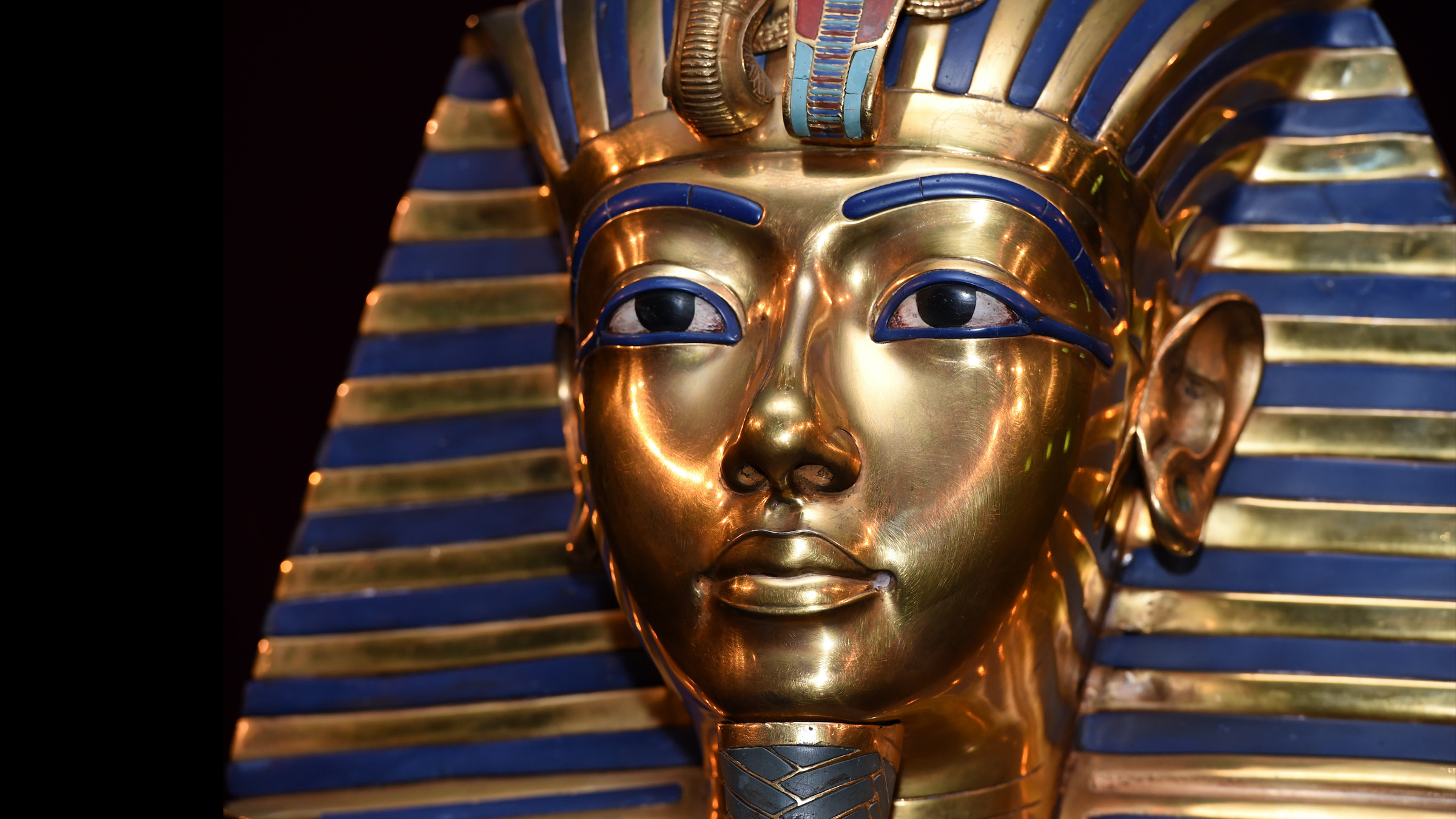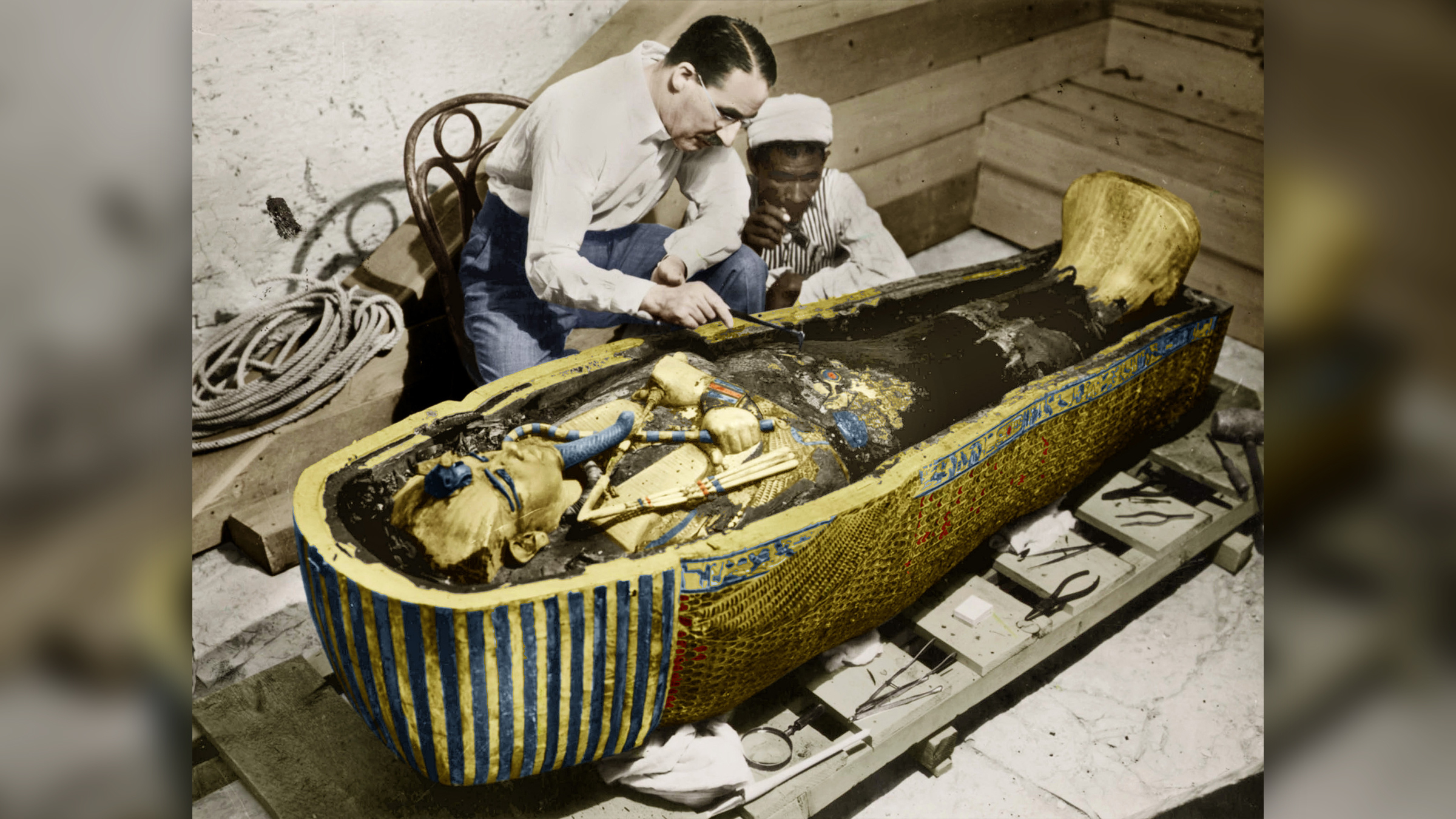What is the ancient Egyptian 'mummy's curse'?
The idea of a "mummy's curse" actually precedes Tut's discovery.

Within months of the discovery of King Tutankhamun's tomb in 1922, the man who financed its excavation — George Herbert, the fifth Earl of Carnarvon in England — became ill and dropped dead. It didn't take long for people to question whether a "mummy's curse" had doomed the earl.
"Pharaoh's 3,000 year-old Curse is Seen in Illness of Carnarvons" read the headline on the front page of the March 21, 1923, edition of "The Courier Journal," a newspaper published in Louisville, Kentucky.
Similar headlines appeared in newspapers around the world as news broke of Carnarvon's illness and death. He suffered an infection that reportedly resulted from a shaving accident when he cut a bite mark made by a mosquito. Reports claimed that his wife, Almina Herbert, was also ill, but she recovered and would live until 1969, dying at the age of 93.
Despite Almina's longevity, her husband's death raises a question: Is there any evidence supporting the concept of a mummy's curse?
Related: How do we decipher Egyptian hieroglyphics and other ancient languages?
Carnarvon had been financing the search for and excavation of Tutankhamun's tomb. When Howard Carter found the tomb in November 1922, he delayed exploring inside until Herbert could arrive from Britain. After Carnarvon's arrival, they ventured into the tomb, seeing the "wonderful" artifacts buried with Tutankhamun. No writing from ancient Egyptians mentioning a curse was found in the tomb.
While the notion of a "curse" may sound ridiculous, it has actually been studied seriously by scientists, with several papers published on the topic. In an effort to determine whether a long-lived pathogen could have caused the "curse," scientists used mathematical modeling to determine how long a pathogen could survive inside a tomb, according to papers published on the subject in 1996 and 1998 in the journal Proceedings of the Royal Society B: Biological Sciences.
Get the world’s most fascinating discoveries delivered straight to your inbox.
"Indeed, the mysterious death of Lord Carnarvon after entering the tomb of the Egyptian pharaoh Tutankhamun could potentially be explained by an infection with a highly virulent and very long-lived pathogen," Sylvain Gandon wrote in the 1998 journal article. Gandon was a researcher at Pierre and Marie Curie University in Paris when the paper was published.
However, more recent publications appear to rebut this possibility. An analysis of brown spots on Tutankhamun's tomb found that "the organism that created the spots is not active," a team of researchers wrote in a paper published in 2013 in the journal International Biodeterioration & Biodegradation.
Additionally, a study published by Mark Nelson, a professor of epidemiology and preventive medicine at Monash University in Australia, found no evidence that those who went inside the tomb died at unusually young ages. His study examined records of 25 people who worked or went into the tomb shortly after it was discovered. On average, the people who went inside the tomb lived to be 70 years old, an age of death that was not particularly low in the early to mid-20th century. The study found "no evidence to support the existence of a mummy's curse," Nelson wrote in a 2002 paper published in the British Medical Journal.
Origins of the curse
The idea of a mummy being associated with a curse actually predates the discovery of Tutankhamun's tomb. "The curse is a legend that developed gradually, since sometime in the mid-19th century, and has grown progressively with cumulative contributions by fiction literature, horror films, news media and most recently, the internet," said Jasmine Day, an Egyptologist who holds a doctorate in cultural anthropology and wrote the book "The Mummy's Curse: Mummymania in the English-Speaking World" (Routledge, 2006).
Related: Who built the Egyptian pyramids?
"My research uncovered forgotten American fiction stories from the 1860s, in which male adventurers strip female mummies and steal their jewels, only to suffer a horrible death, or dreadful consequences for those around them," Day told Live Science. "These stories, written by women, emphasise the unwrapping of mummies as a metaphor for rape. In turn, this shocking comparison seems to condemn the destruction and theft of Egypt's heritage in the heyday of Western colonialism."
Other scholars agreed that the association of curses and magic with mummies was widespread before the discovery of Tutankhamun's tomb. "The idea that Egypt was a land of mystery went back to the Greeks and the Romans," said Ronald Fritze, a history professor at Athens State University in Alabama and author of the book "Egyptomania: A History of Fascination, Obsession and Fantasy" (Reaktion Books, 2016). "Over time, the ancient Egyptians were credited with all sorts of supernatural and magical knowledge."
"When Egypt began to open up to the West after the expedition of Napoleon, there was a fascination with mummies, and well-to-do people bought them to have them unwrapped as entertainment," Fritze added. "Many people were troubled by this sort of meddling with the dead." At that time, fictional stories that told of curses associated with mummies began to appear in literature. Fritze noted that Irish author Bram Stoker, who is most famous for his "Dracula" novel, published a 1903 book called "The Jewel of the Seven Stars," in which modern-day archaeologists suffer from a mummy's curse.
Cinema also picked up on the idea of a curse being associated with mummies said Eleanor Dobson, a lecturer of English literature at the University of Birmingham in the U.K. and author of the book "Writing the Sphinx: Literature, Culture and Egyptology" (Edinburgh University Press, 2020). "Essentially, by the time of Carnarvon's death, audiences were primed to see discoveries of Egyptian artefacts in terms of these Gothic narratives," Dobson told Live Science in an email.
Day noted that when the Titanic sank in 1912, some people believed that the mummy of a priestess in the British Museum had caused the sinking. British Museum curator Ernest Wallis Budge "received so many public enquiries regarding the allegedly cursed mummy at the museum that he was obliged to write a flyer debunking the rumours that could be distributed to members of the public," Day said in an email. "Despite this, some people sent money for the museum to purchase flowers to lay at the feet of the dead priestess to placate her soul — and the tale of the mummy that sank the Titanic continues to circulate on the internet today."
Related: Why were the ancient Egyptians obsessed with cats?
The curse explodes
The press exclusive sold to the Times of London played a major role in the spread of the idea that Tut's tomb was cursed. Other media outlets were outraged that they were shut out and ran stories on the curse, Day said.
"Foremost among the disgruntled reporters was Arthur Weigall, a journalist, novelist, former Egyptologist and bitter rival of Howard Carter," Day said. When Carnarvon died, "Weigall pounced, claiming that the curse of Tutankhamun had killed him," even though Weigall reportedly did not believe in the curse himself.
"Millions of gullible people, however, were eager to believe the tale [of a curse], having been raised on a diet of curse lore and fiction for decades — and desperate to confirm the idea that it was possible to communicate with the dead, having lost so many young men during World War I," Day said, and Carter blamed Weigall for the idea that the tomb was cursed.
The fact that a number of famous authors believed in the curse — such as Arthur Conan Doyle, the writer of the Sherlock Holmes novels — help spread belief in the curse, Day said. Doyle "stated to the press that Carnarvon had been killed by 'elementals,' protective spirits living in the tomb," Day said.
Carter himself got involved in the curse brouhaha when he teamed up with a magazine writer named Percy White in 1923 to write a semifictional magazine story called "Tomb of the Bird: Death of the White Canary" that told an account of the death of Carter's pet canary. "It was a semifictionalised account of the death of Carter's canary, supposedly from a scare or bite from a cobra," Day said. "Carter's indulgence in curse speculations came back to haunt him, however, when newspapers were awash with more lies than truth about Tutankhamun's alleged curse, which irked him."
Related: How were the Egyptian pyramids built?
Curse today
Even today, some people like to link archaeological discoveries and contemporary events with curses. When a massive 2,000-year-old sarcophagus was found in Alexandria, Egypt, in 2018, some people feared that opening it would unleash a curse. Similarly, when a ship blocked the Suez Canal in 2021, some people tried to place the blame on mummies, noting that the mummies of several ancient Egyptian pharaohs were set to be transported to a museum in Fustat.
"People want life to have meaning and not be chaotic and random or coincidental," Fritze said. "Traditionally, formal religion has supplied that need to explain existence. But many people have [turned] to magical and supernatural beliefs, and these include curses."
Originally published on Live Science.

Owen Jarus is a regular contributor to Live Science who writes about archaeology and humans' past. He has also written for The Independent (UK), The Canadian Press (CP) and The Associated Press (AP), among others. Owen has a bachelor of arts degree from the University of Toronto and a journalism degree from Ryerson University.


